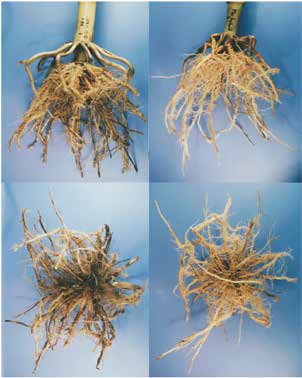Chapter 11
CroP rotations
. . . with methods of farming in which grasses form an important part of the rotation, especially those that leave a large residue of roots and culms, the decline of the productive power is much slower than when crops like wheat, cotton, or potatoes, which leave little residue on the soil, are grown continuously.
—henry snyder, 1896
There are very good reasons to rotate crops. Rotating
legume harvested for seed, such as soybeans, provides
crops usually means fewer problems with insects,
little N for the following crop. On the other hand, a
parasitic nematodes, weeds, and diseases caused by
multiyear legume sod such as alfalfa may well supply
plant pathogens. Rotations that include nonhost plants
all the nitrogen needed by the following crop. Growing
are effective for controlling insects like corn rootworm,
nematodes like soybean cyst nematode, and diseases
croP And vArIetAL MIxtures
like root rot of field peas. When specific soil diseases are
Not only do rotations help in many ways, but growing
present, the length of time between growing the same
mixtures of different crops and even different variet-
or similar crop may vary from relatively short (one to
ies (cultivars) of a given crop sometimes offers real
two years for leaf blight of onions) to fairly long (seven
advantages. For example, faba (fava) bean helps corn
years for clubroot of radish or turnip). Also, the rotation
to get phosphorus on low P soils by acidifying the area
should contain some crops that are nonhosts or actually
around its roots. Also, when some varieties of a spe-
suppress the disease. Root growth may be adversely
cies are prized for a certain quality, such as taste, but
affected when continuously cropping to any single crop
are susceptible to a particular pest, growing a number
(see figure 11.1). This means that the crops may be less
of rows of the susceptible variety alternating with
efficient in using soil nutrients and added fertilizers.
rows of resistant varieties tends to lessen the severity
In addition, rotations that include legumes may supply
of the pest damage.
significant amounts of nitrogen to succeeding crops. A
Photo courtesy the Rodale Institute
115
Building SoilS for Better CropS: SuStainaBle Soil ManageMent





